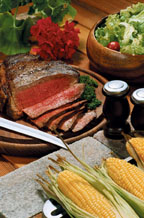Soy Sauce Enhances Foods

There are many soy sauces on the market, but true fermented soy sauce, with all its depth and flavor nuances, takes Yamasa Corporation USA, with American headquarters in Salem, Oregon, more than six months to make. The company claims its six-month fermentation process is one of the longest in the industry and it is a vital step in forming the product's unique flavor notes. “Hydrolyzed soy sauces simply lack the flavor depth and beneficial amino acid profile that true soy sauce does,” states Michael Loera, national sales manager.
A Tradition of Three Hundred Years
The company's process begins by cultivating steamed soybeans and ground, roasted wheat, which is then combined with koji, a starter similar to sourdough. In this process, Yamasa uses the same starter it has used for more than three centuries, resulting in its unique trademark flavor and amino acid profile. The mixture rests for three days in a warm and humid koji room, a process critical to its flavor and aroma. A brine solution of sea salt and water is mixed in with the koji, to make what is called moromi, yet another crucial step in the sauce's final flavor and color profile. The moromi is fermented in controlled tanks with air agitators for six months before becoming fully mature. During this slow process, the amino acid profile develops, as does the complexity of notes, made up of salt, sweet, sour, savory and other flavors that are part of this naturally-brewed soy sauce.The moromi is wrapped in a cloth and pressed, and the mixture is separated into raw soy sauce and soy sauce cake (the residue, which is then used for animal feed). The raw soy sauce is pasteurized, and the high heat also helps develop the flavor profile. After filtration, the heated soy sauce becomes the finished product. Yamasa's soy sauce has won the 2000, 2001 and 2002 American Tasting Institute's award for best flavor enhancer.
A Flavor Enhancer
A misconception about soy sauce is that it should be the dominant flavor in a dish when, in fact, it is meant to be a flavor enhancer. “When adding soy sauce, one is not adding soy flavor but bringing out the flavors in a formula. Soy sauce heightens the flavor of meat, chicken, fish and cheese, or whatever dish it is added to, without masking other flavors. Those who want additional soy sauce flavor can use it as a dipping sauce,” explains Loera.Soy sauce is offered in several formats, to accommodate a wide variety of applications, and there are no added MSG or HVPs. The traditional liquid form, with and without preservatives, is a unique blend of savory, sweet, salty and sour flavors. It is reddish brown and can be used in entrees, frozen dinners, salad dressings, sauces, marinades and anywhere salt can be replaced to add more flavor. A less-salt product also is available. The spray-dried form can be used in powdered mixes, dips, soups, and snack coatings, and in au jus and spaghetti sauces; it also can be used in beef, chicken and cured meats. Teriyaki sauces can be applied as a marinade for meats, poultry or fish, sauces for vegetables, and as an ingredient in barbecue sauces, steak sauces and Asian entrees.
For more information:
Michael Loera at 310-944-3883, ext. 103
Mloera001@aol.com
Yamasa Corporation USA Write in 202
Looking for a reprint of this article?
From high-res PDFs to custom plaques, order your copy today!



